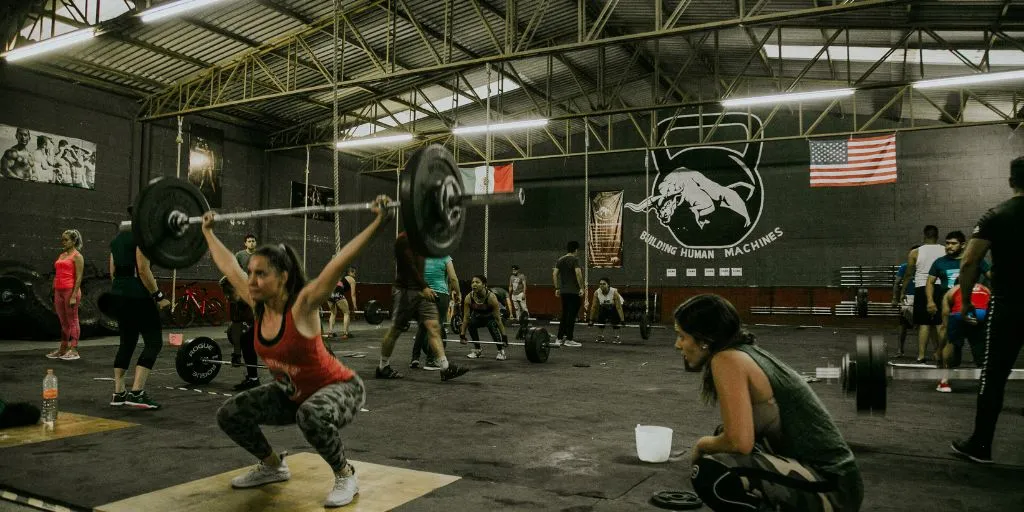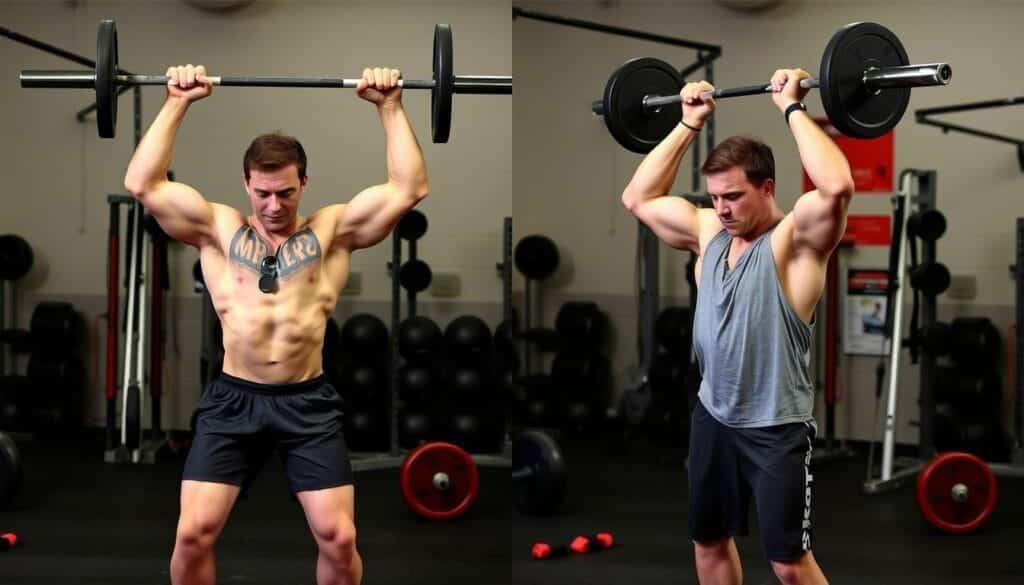What Is STO in CrossFit? A Beginner’s Guide to Shoulder-to-Overhead Movements
Every fitness journey starts with a single lift. When I first went to a CrossFit gym, the Shoulder-to-Overhead (STO) movement looked tough. I wondered how it could change my strength and fitness.
STO in CrossFit is a group of overhead lifts that test your whole body. It doesn’t matter if you’re new or experienced. Learning these techniques can take your fitness to new heights. CrossFit athletes use STO to get stronger, more powerful, and better at moving their muscles.
These movements include push presses and push jerks. They work many muscles at once. This makes you more athletic and gives you a workout that’s different from just lifting weights.
Table of Contents
Understanding Shoulder-to-Overhead (STO) Movements
In CrossFit, STO movements are key exercises. They test your strength, power, and coordination. These movements help athletes build upper body strength and explosiveness.
Definition of STO
STO in CrossFit means moving a weight from your shoulders to overhead. It needs precise timing, muscle use, and technical skill. You can use a barbell, dumbbells, or kettlebells, but the goal is the same.
Importance of STO in CrossFit
STO movements are vital for athletic performance. They offer many benefits:
- Boost upper body strength
- Improve power
- Develop explosive movements
- Enhance functional fitness
“In CrossFit, STO movements are not just exercises—they’re a testament to an athlete’s technical prowess and physical capabilities.”
Common Variations of STO
CrossFit athletes use different STO variations to work on strength and power:
- Strict Press: Focuses on pure shoulder strength
- Push Press: Adds leg drive for more power
- Push Jerk: Uses leg drive and a quick drop under the weight
- Split Jerk: The most complex, with a split-stance technique
Each variation tests your body in different ways. This makes STO a key part of CrossFit training.
Benefits of Shoulder-to-Overhead Exercises
STO in CrossFit changes the game for athletes. These movements do more than just build strength. They offer a wide range of benefits that can boost your CrossFit skills and athletic performance.
Building Upper Body Strength
Shoulder-to-overhead exercises work many muscles at once. Your shoulders, triceps, and upper chest get a great workout. Doing STO in CrossFit regularly helps you:
- Get stronger muscles
- Gain upper body power
- See better muscle shape
Enhancing Core Stability
Core strength is key in shoulder-to-overhead exercises. These movements require precise control and positioning. This helps strengthen your core, leading to better performance and less injury risk.
Improving Overall Fitness
STO exercises improve your fitness in many ways. They combine strength, coordination, and power in one move. Athletes see big gains in:
- Functional strength
- Movement efficiency
- Athletic performance
“STO movements are not just exercises; they’re a gateway to total body transformation.” – CrossFit Training Manual
Adding shoulder-to-overhead exercises to your routine opens up new fitness possibilities. It’s a step towards reaching your full physical and fitness goals.
Key Techniques for Shoulder-to-Overhead
Mastering STO in CrossFit needs precision, technique, and knowing the basics. Athletes aiming to get better at shoulder-to-overhead must focus on key technical points. These points help you move better and avoid injuries.
Doing STO movements well means paying close attention to many parts of your training. Let’s look at the main things that will help you do better in CrossFit.
Proper Posture and Alignment
Your body’s position is key during STO movements. To stay strong and stable, make sure to:
- Keep your spine straight
- Use your glutes and abs
- Keep your torso upright
Breathing Techniques
Good breathing can really help your STO performance. Try these tips:
- Breathe in before lifting the barbell
- Push out air when pressing overhead
- Hold your core tight during the toughest part
Gripping the Barbell
| Grip Width | Benefits | Considerations |
|---|---|---|
| Shoulder-Width | Best for power transfer | Recommended for beginners |
| Slightly Wider | Less shoulder work needed | May not be as efficient |
| Narrow | More tricep work | Needs advanced technique |
Getting good at STO in CrossFit takes time and regular practice. Focus on getting better slowly and always put proper form first, not how heavy you can lift.
*”Technique before intensity – master the movement, then add the weight.”* – CrossFit Training Principle
Differentiating Between STO Variations
Exploring sto in crossfit means knowing the different shoulder-to-overhead (STO) movements. Each one has its own benefits and challenges. These can greatly affect your CrossFit performance.
Press vs. Push Press: Understanding the Mechanics
In CrossFit, the strict press and push press are two different overhead lifts. Here’s what sets them apart:
- Strict Press: Uses only upper body strength, no leg drive
- Push Press: Adds leg momentum for more power
Push Jerk vs. Split Jerk: Foot Positioning Matters
The push jerk and split jerk are advanced STO techniques. They require precise movement and coordination. The main difference is in foot positioning:
| Movement | Foot Position | Power Generation |
|---|---|---|
| Push Jerk | Feet remain shoulder-width | Vertical drive |
| Split Jerk | One foot forward, one back | Enhanced stability and power transfer |
Choosing the Right Variation
Choosing the right STO variation depends on your fitness level, goals, and strengths. Think about these when making your choice:
- Current strength level
- Workout complexity
- Personal comfort and technique
“Mastering STO variations is about understanding your body’s mechanics and progressively challenging yourself.” – CrossFit Training Guide
Safety Considerations in STO Training
Shoulder-to-overhead (STO) movements in CrossFit need careful safety attention. These exercises are great for building strength. But, knowing the risks is key to avoiding injuries during training.
Common Injuries Associated with STO
Performing sto in crossfit can lead to several injuries if safety steps are ignored. The most common problems include:
- Shoulder impingement syndrome
- Lower back strain
- Wrist joint inflammation
- Rotator cuff tears
Tips for Preventing Injuries
To stay safe during STO movements, follow these important steps:
- Do thorough warm-up routines
- Practice exercises that improve shoulder and core mobility
- Keep strict form during movements
- Choose the right weight loads
“Proper technique trumps heavy weights every time in CrossFit training.”
Knowing Your Limits
It’s vital to know your physical limits when doing sto in crossfit. Gradually increase weights and listen to your body to avoid overstraining.
| Training Phase | Weight Progression | Rest Interval |
|---|---|---|
| Beginner | 50-60% max capacity | 90-120 seconds |
| Intermediate | 70-80% max capacity | 60-90 seconds |
| Advanced | 85-95% max capacity | 45-60 seconds |
Remember, gradual progression is key to sustainable CrossFit training.
How to Incorporate STO into Your Routine
Adding shoulder-to-overhead (STO) movements to your CrossFit routine needs careful planning. These exercises boost your strength and performance when done right.

Recommended Weekly Frequency
How often you do STO depends on your fitness and how well you recover. Most CrossFit athletes do STO 2-3 times a week for best results.
- Beginners: 2 sessions per week
- Intermediate athletes: 3 sessions per week
- Advanced CrossFit performers: Up to 4 sessions per week
Suggested Warm-Up Practices
Warming up right is key to avoid injuries during STO training. Focus on exercises that loosen your shoulders, core, and upper body.
- Arm circles and shoulder rotations
- Light PVC pipe pass-throughs
- Dynamic stretching
- Lightweight barbell movement prep
Example Workout Plans
Make your STO workouts challenging but focus on technique. Here’s a sample plan:
| Day | STO Focus | Repetitions | Sets |
|---|---|---|---|
| Monday | Push Press | 5-8 reps | 4 sets |
| Wednesday | Push Jerk | 3-5 reps | 5 sets |
| Friday | Split Jerk | 4-6 reps | 3 sets |
“Consistency and proper technique are key to mastering STO movements in CrossFit.” – Professional CrossFit Coach
Always listen to your body and adjust your STO routine as needed. This helps with your progress and recovery.
Tips for Mastering Your STO Technique
Getting better at shoulder-to-overhead (STO) in CrossFit takes hard work and a smart plan. It doesn’t matter if you’re just starting or have been doing it for years. Learning the right way to do STO can make you stronger and safer.
Importance of Proper Form
Good form is key to doing STO well in CrossFit. How your body is set up affects how much power you use and how well you do. Pay attention to these important points:
- Keep your spine straight
- Use your core muscles
- Keep the bar moving straight up
“Technique trumps weight every single time in CrossFit training.” – Greg Glassman
Focusing on Movement Mechanics
Breaking down STO into parts helps you learn and get better. Focus on these main steps:
- Start with the bar in the right spot
- Use your legs to push
- Extend your shoulders and arms
- Stabilize the bar overhead
Utilizing Tools and Resources
Improving your STO in CrossFit means using the right tools. Think about using:
- Video analysis platforms
- Coaching from experts
- Drills that slow down the movement
- Training to improve your flexibility
Remember, getting good at STO in CrossFit is a long journey. Be patient and keep practicing. With time and effort, you’ll reach your full ability.
Common Mistakes to Avoid in STO
Doing shoulder-to-overhead (STO) movements in CrossFit needs focus and care. Even skilled athletes can make mistakes that hurt their form and safety. Knowing these common errors can help you improve your STO and stay safe.

Overextending the Back
One big mistake in STO is arching your lower back too much. When lifting the barbell overhead, your spine should stay in a neutral position. Too much arching puts strain on your back and can cause injuries.
- Keep your core tight throughout the entire movement
- Maintain a slight posterior pelvic tilt
- Engage your glutes to stabilize your spine
Incorrect Grip Width
Your grip on the barbell is key for STO success. Gripping too wide or too narrow can make the movement less effective and riskier for your shoulders.
“Precision in grip is the foundation of a powerful overhead movement.” – Elite CrossFit Coach
Neglecting Core Engagement
A weak core can ruin your STO technique. Your core muscles are vital for stability in overhead lifts. Without strong core engagement, you’ll find it hard to keep proper form and power in your STO workouts.
- Practice core-strengthening exercises
- Focus on breathing techniques
- Integrate planks and hollow body holds into your routine
Tracking Progress in STO
Tracking your shoulder-to-overhead (STO) performance in CrossFit is key for getting better and staying motivated. Knowing how you’re doing helps you set goals and adjust your training plan.
Setting Realistic Goals
Setting goals for STO in CrossFit needs careful planning. Think about these important points:
- Know your current strength
- Set clear, measurable goals
- Break big goals into smaller steps
Keeping a Training Journal
A training journal is essential for tracking your STO progress. Write down these important details:
- Weight you lift
- How many reps you do
- How hard it feels
- Any notes on your technique
“What gets measured gets improved.” – Peter Drucker
Assessing Your Strength Improvements
Keeping track of strength gains needs regular checks. Use these methods to see how you’re doing with STO:
| Assessment Method | Frequency | Purpose |
|---|---|---|
| Max-out Sessions | Every 8-12 weeks | Find out your max lift |
| Benchmark Workouts | Quarterly | See how you’ve improved |
| Video Analysis | Monthly | Check your technique |
By regularly tracking your STO, you’ll understand your strengths and weaknesses. This helps you stay motivated in your CrossFit journey.
Resources for Further Learning about STO
Learning more about shoulder-to-overhead (STO) movements in CrossFit is exciting. You can find great resources and connect with experts. This will help you get better and stay excited about your fitness journey.
Online Courses and Workshops
Boost your STO skills with online learning. There are many good places to learn:
- CrossFit.com Official Training Modules
- Wodprep Online STO Technique Course
- Breaking Muscle Professional Workshops
- Remote Coaching Programs with Certified Trainers
CrossFit Communities and Groups
Joining CrossFit groups can really help you get better at STO. You’ll learn from others and get support:
- Reddit r/CrossFit Community
- Facebook CrossFit Training Groups
- Instagram CrossFit Hashtag Networks
- Local CrossFit Box Community Channels
Expert Coaches to Follow
Follow these CrossFit pros for inspiration and tips on STO:
| Coach | Platform | Specialty |
|---|---|---|
| Ben Bergeron | Competition Coaching | |
| Mat Fraser | YouTube | Olympic Lifting Techniques |
| Julie Foucher | Personal Website | Functional Movement |
“Continuous learning is the key to mastering STO in CrossFit. Embrace every opportunity to grow and improve.” – CrossFit Training Manual
Remember, your STO journey is special. These resources are helpful, but practice and staying consistent are key to getting better.
Conclusion: Embracing STO in Your CrossFit Journey
Exploring Shoulder-to-Overhead (STO) movements in CrossFit is a big step in your fitness journey. These exercises do more than build muscle. They improve your athletic performance and strength.
Learning about STO in CrossFit means training in a way that challenges you. It’s about pushing your body and mind to new limits.
Key Points to Remember
Learning STO techniques teaches you about form, safety, and how to get better. Each type of STO, like the press or jerk, has its own benefits. Mastering these movements can take your fitness to new heights.
Your Path Forward
Practice is key in STO training. Begin with light weights and focus on your technique. Then, slowly add more challenges. CrossFit pros say skill takes time to develop.
Your dedication to learning and improving will help you succeed. It’s all about being willing to learn and keep going.
Future Growth Potencial
Your journey with STO in CrossFit is always growing. As you get better, you’ll unlock new strengths and abilities. Stay open to learning and patient with yourself.
See every workout as a chance to grow and change. It’s a journey of self-improvement and personal growth.

